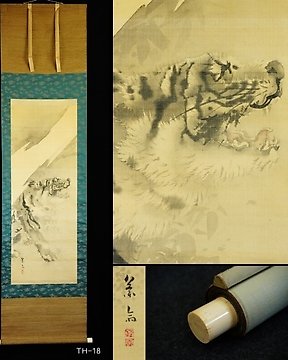
Tiger - ca 1800-1900s (Late Edo / Meiji) - After Mori Ransai 森蘭斎(1740-1801) - Japan - Late Edo period (No Reserve Price)
No. 81347615

No. 81347615

Emakimono 絵巻物 (horizontal picture scroll) - Kozo washi - 江戸時代の風俗絵巻 Edo jidai no fūzoku emaki - Edo customs - Sealed Kazan Noboru 華山登 (1793-1841) - 華山登 - ca.1825
Here for auction an impressive emakimono 風俗 fuzoku (depicting customs) scroll. Handpainted over more than 6 meters (660 cm) and 27.5 cm width, binded in kansuso (scroll binding) method in fine thick kozo washi. Some colors remained vivid, some faded. Backlight photographies show some foxing, very few minor and small worm holes. No creases or wrinkles, no tears. All of the scroll's images is photographed here and any damage can be seen. I suspect the kansuso scroll binding was re-done much later in Meiji era since is in a much better condition than the paper.
The style of the brushwork resembles very much a later published (1884) work of Kazan: https://www.britishmuseum.org/collection/object/A_1979-0305-0-384 ---Isso hyakutai 一掃百態
I suspect these were early preliminary sketches, made into emakimono binding later.
Photos show:
1. Normal lighting (no flash) - as it is
2. Backlighting - to show the condition of the paper, the striations characteristic to handmade washi and any damage. yellowish due to age and some minor foxing is visible
3. Seal comparison with known seals in databases
Additional links to compare seal:
1. https://www.christies.com/en/lot/lot-4250798
2. https://www.christies.com/en/lot/lot-4150856
3. https://harvardartmuseums.org/collections/object/30696
There are occasional stains and delamination of the paper. The main painting area is backed by another sheet of fine kozo washi.
Sealed in red hanko 'Kazan Noboru' 華山登 . The seals match those in libraries/databases and Watanabe sold scrolls
Another circular seal added later, most probably the owner.
A rare find, a well deserved place in any serious collector's library. The scroll is extremely interesting, further research can be done upon it. The scroll deserves an in-depth research carried by an expert.
***Kansuso (a hand scroll or horizontal scroll) means a binding style of a horizontally long sized scroll of paper (or silk cloths on rare occasions) made up of many rectangular sheets connected side by side in lateral direction, and equipped with a roller on one end of the sheet to wind the whole sheet up on it to store the scroll, and we call various documents, Buddhist sutras, and other paintings, which are made up in this kansuso method of binding, as 'kansubon' or more generally 'makimono.'
How to buy on Catawiki
1. Discover something special
2. Place the top bid
3. Make a secure payment